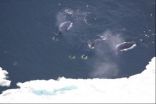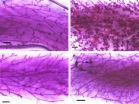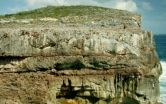(Press-News.org) NEW YORK (March 16, 2012)—A rapid increase in shipping in the formerly ice-choked waterways of the Arctic poses a significant increase in risk to the region's marine mammals and the local communities that rely on them for food security and cultural identity, according to an Alaska Native groups and the Wildlife Conservation Society who convened at a recent workshop.
The workshop—which ran from March 12-14—examined the potential impacts to the region's wildlife and highlighted priorities for future management of shipping in the region. The meeting included participants from the Alaska Eskimo Whaling Commission, Eskimo Walrus Commission, Alaska Beluga Whale Committee, Ice Seal Committee, Indigenous People's Council for Marine Mammals, and the Inuit Circumpolar Council. Other participants included the University of Alaska, government agencies such as the U.S. Coast Guard, Arctic Research Commission, and the Marine Mammal Commission, and regional Alaska Native groups such as Kawerak Inc., North Slope Borough, Northwest Alaska Borough, and Association of Village Council Presidents.
At issue is the effect of climate change on Arctic waters, which over the last few decades have become increasingly ice-free during the summer and fall. The lengthening of the open-water season has led to new industrial developments, including oil and gas activities and a rising number of large maritime vessels transiting either the Northern Sea Route over the Russian Arctic from Europe, or the Northwest Passage through the Canadian Arctic from the Atlantic. Whichever route is being used, the only gateway to the Pacific is through the Bering Strait—an important migratory pathway for marine mammals. In spring and fall for example, almost the entire bowhead whale and walrus populations migrate through this narrow strait.
Workshop participants gathered to discuss the impact of more shipping traffic in both international and national waters between Alaska and Russia on marine mammals, including the bowhead whale, beluga whale, walrus, several seal species, and polar bear.
In the past, multi-year sea ice in the Arctic basin that extended to both the Canadian and Russian Federation coastlines had been a serious obstacle for large ships.
"The disappearance of summer sea ice from the region's coastal areas is leading to major changes in this part of the world," said Dr. Martin Robards, Director of WCS's Beringia Program and one of the event's organizers. "The presence of large ocean-going vessels is expected to increase as the region becomes more attractive to both international shipping and extractive industries seeking minerals, oil, and gas. The northern sea route is 30 percent shorter than the comparable route linking northern Europe to Asia via the Suez Canal, which only supports the conclusion that the Bering Strait is likely to get busier. We need to ensure that the mutual interests shared by Alaska Natives and the conservation community for the health and safety of marine mammals are included in the protection of the region's natural resources."
A number of studies have raised significant concerns about the impacts from shipping and resource extraction on large whales. The North Atlantic right whale, a close relative of the bowhead whale, occurs in heavily industrialized waters of the East Coast of North America. Estimated to number only between 400-450 individuals, the North Atlantic right whale is threatened by mortalities from vessel strikes and entanglement in fishing gear. Based on scientific insights that reflected the needs of these whales, new speed restrictions, navigational alternatives, and vessel tracking systems in areas of importance to North Atlantic right whales were successfully implemented in Canadian and U.S. waters, minimizing the possibility of large vessels striking whales. Similar accommodations—particularly in funnel areas such as the Bering Strait—will become essential as vessel traffic increases, if strikes and other impacts to bowhead whales are to be minimized.
Apart from the risk of ship strikes, large vessels also emit low-frequency noises that can disrupt important behavioral functions for whales and potentially impair their ability to communicate and navigate. Degradation of the acoustic habitat can have consequences not only for whales, but also for other marine mammals such as walrus, and even fish.
"There is mounting evidence that human-generated sounds in the marine environment have negative effects on marine life," said Dr. Howard Rosenbaum, Director of The Wildlife Conservation Society's Ocean Giants Program. "An increase in background noise from increased shipping, coupled with increases in underwater noise from industrial activities and other potential stressors, is of great concern for the Arctic's marine species and their important habitats."
Another threat to bowheads and other Arctic denizens: an oil spill in a region with little or no capacity for containment.
"The lack of international response capability to a spill in these waters is a serious concern in light of the increased interest in oil and gas exploration, or the rise in transportation of petroleum products by tankers through the Arctic," added Robards. "A comprehensive approach is clearly needed to prepare for a potential environmental disaster in a region where marine mammals transit both national and international waters."
Outcomes from the workshop will help inform both future research on the effects of development on fragile Arctic ecosystems and support Alaska natives as they seek to actively protect the health and safety of the marine mammal populations they rely on. This will help engage local communities and their representatives with the regulatory decisions being made by the U.S. Coast Guard, the U.S. and Russian Governments, and the International Maritime Organization.
"The involvement of local communities in this process is crucial for both the cultural integrity and the conservation of the Arctic," said Dr. Caleb McClennen, Director of the Wildlife Conservation Society's Marine Conservation Program. "This workshop will ensure that Alaska's Native organizations have a seat at the table for the key decisions on the future of this biologically diverse region."
INFORMATION:
The Wildlife Conservation Society saves wildlife and wild places worldwide. We do so through science, global conservation, education and the management of the world's largest system of urban wildlife parks, led by the flagship Bronx Zoo. Together these activities change attitudes towards nature and help people imagine wildlife and humans living in harmony. WCS is committed to this mission because it is essential to the integrity of life on Earth. Visit www.wcs.org.
Special Note to the Media: If you would like to guide your readers or viewers to a web link where they can make donations in support of helping save wildlife and wild places, please direct them to: www.wcs.org/donation
Increase in Arctic shipping poses risk to marine mammals
2012-03-19
ELSE PRESS RELEASES FROM THIS DATE:
Glacier-fed river systems threatened by climate change
2012-03-19
Glacial meltwater increases biodiversity in mountainous freshwater ecosystems. As glaciers vanish due to global warming, so will those species dependent upon the icy runoff. This is the conclusion of a study authored by researchers from, among other institutions, the University of Copenhagen.
The article "Glacial river biodiversity" with the alarming new findings can be found in the journal Nature Climate Change.
"The knowledge is new and startling. Glacial runoff is cold, nutrient-poor and physically unstable, and therefore, typically species-poor. Traditionally, we ...
Researchers print live cells with a standard inkjet printer
2012-03-19
Researchers from Clemson University have found a way to create temporary holes in the membranes of live cells using a standard inkjet printer. The method will be published in JoVE, the Journal of Visualized Experiments, on March 16.
"We first had the idea for this method when we wanted to be able to visualize changes in the cytoskeleton arrangement due to applied forces on cells," said paper-author Dr. Delphine Dean.
She said other researchers have been using this method to print cells onto slides, but that they have only recently discovered that printing the cells ...
Study determines critical skills for PCPs to safely manage opioid risk in chronic pain patients
2012-03-19
The study's objective was to identify which skills and competencies are considered most critical for primary care providers (PCPs) to learn in order to effectively manage opioid risk in patients treated for chronic pain
Study participants included experts in primary care, pain management, and addiction
Experts in this study identified the most important skills for PCPs managing opioid risk in chronic pain patients as how to monitor opioids and how to assess for risk factors
Primary care physicians are faced with treating a large proportion of chronic pain patients, ...
Building the European Union's Natura 2000 -- the largest ever network of protected areas
2012-03-19
The European Union's Habitats Directive is now 20 years old, and its network of protected areas, known as Natura 2000, is nearing completion. After a slow start, the network now includes some 26 000 protected sites and covers approximately 18% of the EU's land surface as well as significant areas of sea. It is widely considered to be the world's largest network of protected areas based on agreed site selection criteria. The review has been published in the newly launched open-access journal Nature Conservation.
Douglas Evans, seconded to the Paris-based European Topic ...
Highly exposed to phthalates as fetuses, female mice have altered reproductive lives
2012-03-19
PROVIDENCE, R.I. [Brown University] — Female mouse fetuses exposed to very high doses of a common industrial chemical that makes plastics more pliable develop significant reproductive alterations and precancerous lesions as they grow up, according to a new toxicology study conducted at Brown University.
The administered doses of MEHP, the chemical that results when animals metabolize the industrial phthalate DEHP, were much higher than any normal environmental exposure that people or animals would encounter, said Mary Hixon, assistant professor of pathology and laboratory ...
Sharing patents with competitors may encourage innovation, UB study suggests
2012-03-19
BUFFALO, N.Y. -- Firms that make a previously patented innovation accessible to competitors increase overall likelihood of improving upon that breakthrough while also raising profits for the original innovator and market welfare, according to a study by a University at Buffalo economist.
The practice of free-licensing -- giving up patent protection -- corresponds to an evolutionary step in the study of patents and their effect on innovation, says the study's author Gilad Sorek, assistant visiting professor of economics at UB.
"This research arose from the notion that ...
Response rate high for some patients with metastatic melanoma treated with vemurafenib
2012-03-19
TAMPA, Fla. (March 16, 2012) – An international team of researchers from the United States and Australia, including researchers at Moffitt Cancer Center in Tampa, Fla., have found that the oral BRAF inhibitor vemurafenib (PLX4032) when tested in a phase II clinical trial offered a high rate of response in patients with previously treated metastatic melanoma and who had the BRAF mutation. More than 50 percent of the patients in the trial had positive, prolonged responses and a median survival of almost 16 months.
The study was published in a recent issue of the New England ...
Nanopills release drugs directly from the inside of cells
2012-03-19
UAB researchers developed a new vehicle to release proteins with therapeutic effects. The vehicles are known as "bacteria inclusion bodies", stable insoluble nanoparticles which are found normally in recombinant bacteria. Even though these inclusion bodies traditionally have been an obstacle in the industrial production of soluble enzymes and biodrugs, they were recently recognised to have large amounts of functional proteins with direct values in industrial and biomedical applications.
The research team led by Antoni Villaverde from the Institute of Biotechnology and ...
AGU journal highlights March 16, 2012
2012-03-19
The following highlights summarize research papers that have been recently
published in Geophysical Research Letters (GRL), Journal of Geophysical
Research-Atmospheres (JGR-D), and Journal of Geophysical Research-Solid
Earth (JGR-B).
In this release:
Measuring mercury in coastal fog water
Early Eocene climate warming increased petroleum production
Unexpected earthquakes within continental plates pose challenges
Land use changes contribute to climate extremes
When will warming-induced rainfall changes be perceptible?
Model describes New Zealand's complex tectonic ...
New research lowers past estimates of sea-level rise
2012-03-19
The seas are creeping higher as the planet warms. But how high could they go?
Projections for the year 2100 range from inches to several feet, or even more.
The sub-tropical islands of Bermuda and the Bahamas are two seemingly unlikely places scientists have gone looking for answers.
The cliffs and ancient reefs on Bermuda and the Bahamas have lured fossil-hunters for decades. The land on the Bahamas, for example, has a foundation of fossil coral; the stone is derived from the disintegration of age-old coral reefs and seashells.
These areas are now attracting scientists ...




